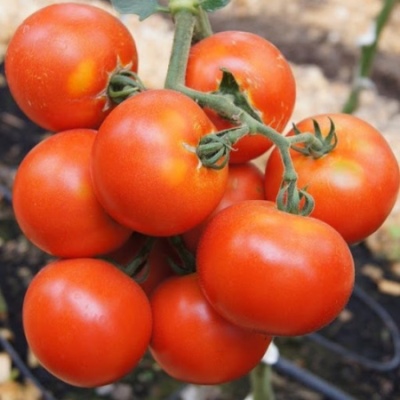
- Authors: Russia
- Year of approval: 1999
- Name synonyms: Marfa
- Category: hybrid
- Growth type: indeterminate
- Appointment: universal
- Ripening period: mid-season
- Ripening time, days: 124
- Growing conditions: for open ground, for closed ground
- Marketability: high
Such an old-fashioned name does not mean that such a tomato deserves to be disparaged. However, its merits will be revealed only to well-trained gardeners. Information about planting methods, feeding and other horticultural measures plays an important role.
Breeding history
Tomato Martha is one of the most attractive varieties of domestic selection. It was entered in the state register in 1999. It is worth noting that some sources mention the Dutch origin of such a plant.
Description of the variety
Tomato Martha is a universal indeterminate culture. It can be grown both in open gardens and greenhouses. The bushes of Martha rise to more than 2 m. They are characterized by moderate branching and the same degree of foliage. Leaves of such a tomato:
are of the ordinary type;
are of medium size;
differ green, sometimes reaching dark green, color;
cast with a matte glow;
slightly corrugated.
The main qualities of the fruit
Young Martha berries are colored in a light green tone. When they grow up and get stronger, they will acquire a red color. The usual weight of fruits is 130-140 g, up to 12 tomatoes can be seen on 1 brush. They are covered with a glossy skin. Other important points:
keeping quality level - high;
laying of the initial inflorescence above the 8-9 leaf;
bookmark of all subsequent inflorescences with a step of 3 sheets.
Taste characteristics
Tomato Martha is praised for its good sweetness. Its flesh is firm. The inside of the fruit contains relatively few seeds, which does not negatively affect their perception. The meatiness is quite at the level of the best competing varieties. In general, the variety is considered an excellent option from a gastronomic point of view.
Ripening and fruiting
Martha is harvested at the same time as other mid-season varieties. It should be understood that in practice this period can vary greatly depending on the growing conditions. The approximate cultivation time (from germination to fruit) is 124 days. It often changes depending on agricultural technology and other nuances. The harvest is predominantly in July and August.
Yield
The plant belongs to the high-yielding group. The collection rate often reaches 23.6 kg per m2. However, it is also subject to change depending on how the tomato is grown.
The timing of planting seedlings and planting in the ground
Sowing seeds in seedling containers is recommended in the first third of spring. Delaying this moment for too long would hardly be wise. Subject to the usual agricultural techniques, you can get seedlings ready for planting in the ground in April or May. Her condition is always assessed individually.

Growing tomato seedlings is an extremely important process, because it largely depends on whether the gardener will be able to harvest at all. All aspects must be taken into account, from seedbed preparation to planting in the ground.
Landing scheme
It is necessary to plant the Martha tomato in order of 400x600 mm. It is categorically inappropriate to use other options. Important: plants form 1 stem.

Growing and care
The most promising cultivation of tomatoes Martha in the center of the European part of Russia. In more southern regions, this plant can also be cultivated. However, it is not zoned there, and such attempts are made at their own peril and risk. Before planting, it is recommended to disinfect the soil using:
Bordeaux liquid;
Fitosporin;
potassium permanganate;
lime (dissolved in water).
Of the fertilizers, it is recommended to use:
saltpeter;
compost;
wood ash;
phosphorus-potassium compositions.
Water the tomato 2 times a week. In this case, 8-10 liters of water are used per 1 bush. Stepchildren should be removed 1 time per decade. Top dressing is carried out both at the root and on the leaf. Laying mulch with a layer of 7-8 cm is recommended.
In order for the seedlings to develop fully, they are fed a couple of times with the drug "Kemira-universal". Only settled water is suitable for irrigating seedlings. It is advisable to dive bushes in the phase of 3 true leaves. To control harmful insects, it is preferable to use natural remedies, such as:
garlic infusion;
infusion of celandine;
soap solution;
diluted ammonia.
If there are a lot of insects, factory insecticides are already needed. Among them, the drug "Profi" is the best. Before the start of the season, it is recommended to water the ground with vitriol. Magnesium dressings are used to increase yields. The area under the tomatoes is changed annually.




A plant needs different micronutrients at each stage of growth. All fertilizers can be divided into two groups: mineral and organic. Folk remedies are often used: iodine, yeast, bird droppings, eggshells.
It is important to observe the rate and period of feeding. This also applies to folk remedies and organic fertilizers.


Review overview
This hybrid lives up to all farmers' expectations.It grows well even in regions with a difficult climate, such as the Kirov region. The plant will delight those who cannot pay much attention to their plantings with an excellent harvest. Those who have tried to plant such a culture are satisfied and strive to repeat their success. The variety is in demand both among professional farmers and among owners of urban household plots.

























































































